Super Earth (K2-18b): The Shocking Truth Behind the Search for Extraterrestrial Life
Have you ever looked up at the night sky and wondered: are we alone in the universe? This is, without a doubt, one of humanity's deepest and oldest questions. What if I told you that we are closer than ever to an answer? Recently, a video went viral online, with the catchy title: "LIFE ON ANOTHER PLANET? THE MOST IMPACTFUL DISCOVERY OF ALL TIME." The video, which you may have watched, talks about an exoplanet called K2-18b and the possibility that we have found signs of life there. But, as with every great story, the truth is much more complex and fascinating than it seems. In this article, we will dive deep into the story of K2-18b. We will explore what science truly knows about this distant world, the discoveries that made the scientific community hold its breath, and the controversy that followed. We will separate fact from fiction, hear what experts – from renowned scientists to ufologists – have to say, and try to understand what all this means for the future of space exploration and for our own existence. So, get ready for a journey 124 light-years from Earth, to a world that may, or may not, hold the secrets of extraterrestrial life.
CURIOSTYAMAZINGEXTRATERRESTRIAL LIFEPLANETS
Bringing Blessing
6/29/202524 min read
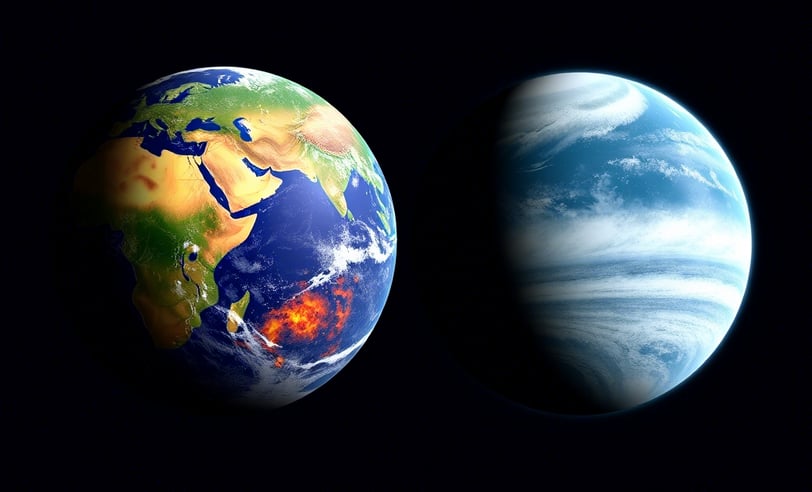

K2-18b: Where It All Began
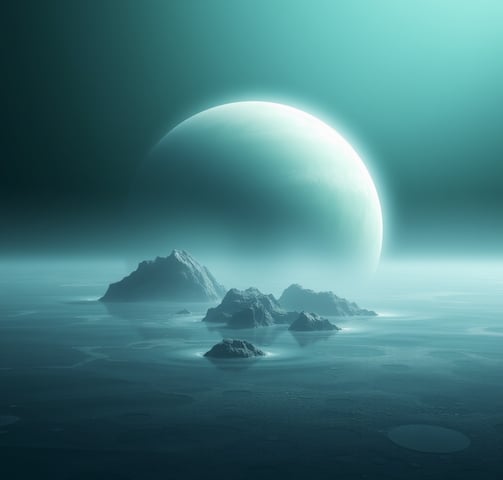

The Discovery of Water and the First Whisper of Hope
Sources Consulted
NASA Exoplanet Archive. K2-18b. Available at: [https://exoplanetarchive.ipac.caltech.edu/overview/K2-18b](https://exoplanetarchive.ipac.caltech.edu/overview/K2-18b)
NASA Science. K2-18 b. Available at: [https://science.nasa.gov/exoplanet-catalog/k2-18-b/](https://science.nasa.gov/exoplanet-catalog/k2-18-b/)
National Geographic. Exoplaneta K2-18 b: por qué se cree que ahí podría haber vida. Available at: [https://www.nationalgeographic.es/espacio/2023/09/exoplaneta-k2-18-b-existe-vida-extraterrestre-planeta-candidato](https://www.nationalgeographic.es/espacio/2023/09/exoplaneta-k2-18-b-existe-vida-extraterrestre-planeta-candidato)
[UCL News. First water detected on potentially 'habitable' planet. Available at: [https://www.ucl.ac.uk/news/2019/sep/first-water-detected-potentially-habitable-planet](https://www.ucl.ac.uk/news/2019/sep/first-water-detected-potentially-habitable-planet)
Sky & Telescope. Water Vapor Found on Habitable-Zone Exoplanet. Available at: [https://skyandtelescope.org/astronomy-news/water-vapor-found-on-habitable-zone-exoplanet/](https://skyandtelescope.org/astronomy-news/water-vapor-found-on-habitable-zone-exoplanet/)
NASA. Webb Discovers Methane, Carbon Dioxide in Atmosphere of K2-18 b. Available at: [https://www.nasa.gov/universe/exoplanets/webb-discovers-methane-carbon-dioxide-in-atmosphere-of-k2-18-b/](https://www.nasa.gov/universe/exoplanets/webb-discovers-methane-carbon-dioxide-in-atmosphere-of-k2-18-b/)
University of Cambridge. Strongest hints yet of biological activity outside the solar system. Available at: [https://www.cam.ac.uk/stories/strongest-hints-of-biological-activity](https://www.cam.ac.uk/stories/strongest-hints-of-biological-activity)
Science.org. Alien planet’s atmosphere bears chemical hints of life, astronomers claim. Available at: [https://www.science.org/content/article/alien-planet-s-atmosphere-bears-chemical-hints-life-astronomers-claim](https://www.science.org/content/article/alien-planet-s-atmosphere-bears-chemical-hints-life-astronomers-claim)
BBC News. Scientists find promising hints of life on distant planet K2-18b. Available at: [https://www.bbc.com/news/articles/c39jj9vkr34o](https://www.bbc.com/news/articles/c39jj9vkr34o)
Nature. Signs of life on a distant planet? Not so fast, say these astronomers. Available at: [https://www.nature.com/articles/d41586-025-01264-z](https://www.nature.com/articles/d41586-025-01264-z)
[arXiv. Insufficient evidence for DMS and DMDS in the atmosphere of K2-18 b. Available at: [https://arxiv.org/html/2505.13407v1](https://arxiv.org/html/2505.13407v1)
Scientific American. Why Astronomers Are Not Sold on New Alien Life Claims. Available at: [https://www.scientificamerican.com/article/why-astronomers-doubt-claims-that-planet-k2-18-b-finding-means-alien-life/](https://www.scientificamerican.com/article/why-astronomers-doubt-claims-that-planet-k2-18-b-finding-means-alien-life/)
Evolution News and Science Today. Life on Exoplanet K2-18b? Available at: [https://evolutionnews.org/2025/04/fact-check-did-scientists-really-detect-evidence-of-life-on-exoplanet-k2-18b/](https://evolutionnews.org/2025/04/fact-check-did-scientists-really-detect-evidence-of-life-on-exoplanet-k2-18b/)
The Planetary Society. A possible sign of life on K2-18b? Here’s…. Available at: [https://www.planetary.org/articles/possible-sign-of-life-k2-18-b](https://www.planetary.org/articles/possible-sign-of-life-k2-18-b)
BBC News. Scientists find promising hints of life on distant planet K2-18b. Available at: [https://www.bbc.com/news/articles/c39jj9vkr34o](https://www.bbc.com/news/articles/c39jj9vkr34o)
Astronomy.com. K2-18 b could have dimethyl sulfide in its air. But is it a sign of life? Available at: [https://www.astronomy.com/science/k2-18-b-could-have-dimethyl-sulfide-in-its-air-but-is-it-a-sign-of-life/](https://www.astronomy.com/science/k2-18-b-could-have-dimethyl-sulfide-in-its-air-but-is-it-a-sign-of-life/)
Reddit. If the dimethyl sulfide detection on K2-18b is confirmed .... Available at: [https://www.reddit.com/r/space/comments/16iq7cz/if_the_dimethyl_sulfide_detection_on_k218b_is/](https://www.reddit.com/r/space/comments/16iq7cz/if_the_dimethyl_sulfide_detection_on_k218b_is/)
This article was written based on extensive research from open sources on the internet, including news portals, social media, and discussion forums. The information presented here reflects the current state of the debate about the Buga Sphere and aims to present different points of view impartially. The veracity of the claims and the interpretation of the facts are the responsibility of the original sources.
The first major news that put K2-18b on the astrobiology map came in 2019. Researchers from University College London (UCL), using data from the Hubble Space Telescope, announced the detection of water vapor in K2-18b's atmosphere. This was a monumental discovery! For the first time, we had evidence of water on an exoplanet in the habitable zone. Dr. Angelos Tsiaras, one of the authors of the UCL study, expressed the team's excitement: "Finding water on a potentially habitable world other than Earth is incredibly exciting".
This water vapor detection was a watershed moment. Before K2-18b, most exoplanets with detected water were "Hot Jupiters" – gas giants orbiting very close to their stars, with extremely high temperatures, making them unsuitable for life. K2-18b, on the other hand, offered a much more promising scenario. The presence of water, combined with its location in the habitable zone, made many begin to dream of the possibility of liquid oceans beneath its clouds. Could these oceans harbor some form of life? The question echoed through the halls of scientific institutions and in the minds of space enthusiasts worldwide.
The James Webb Space Telescope: A New Look at K2-18b
If Hubble gave us the first glimpse of water on K2-18b, the James Webb Space Telescope (JWST) promised us an even deeper view. Launched in 2021, the JWST is the most powerful space telescope ever built, capable of observing the universe in infrared with unprecedented clarity. In September 2023, an international team of astronomers, using JWST data, made an exciting discovery about K2-18b: the detection of methane and carbon dioxide in its atmosphere.
This discovery was crucial because the presence of these gases, along with the absence of ammonia, suggested that K2-18b could be a type of exoplanet known as a "Hycean World." What is a Hycean World? It is a planet with a hydrogen-rich atmosphere that can harbor a vast ocean of liquid water beneath that atmosphere. Think of an ocean planet, but with a much thicker, hydrogen-dominated gaseous layer. This theory, proposed by researchers like Nikku Madhusudhan of the University of Cambridge, opens up a new range of possibilities for the search for life, as these worlds may be more common in the universe than rocky "Earths".
The Dimethyl Sulfide (DMS) Controversy: Signs of Life or False Alarm?
And then, in April 2025, came the news that shook the world: the same team led by Professor Nikku Madhusudhan, from the University of Cambridge, announced the possible detection of Dimethyl Sulfide (DMS) and/or Dimethyl Disulfide (DMDS) in K2-18b's atmosphere. If you're not a chemist, perhaps DMS doesn't mean much, but for astrobiologists, this molecule is a holy grail. On Earth, DMS is almost exclusively produced by living organisms, mainly marine phytoplankton. Its presence on K2-18b, therefore, would be a strong indication of biological activity, a "biosignature".
Madhusudhan's team estimated that DMS concentrations on K2-18b could be thousands of times higher than those found on Earth, reaching more than ten parts per million. This generated headlines worldwide, with many interpreting the discovery as the first concrete evidence of extraterrestrial life. The excitement was palpable, and the question "Are we alone?" seemed closer to being answered than ever before.
However, as with any scientific discovery of such magnitude, skepticism is an essential part of the process. And the case of DMS on K2-18b was no different. Almost immediately, the scientific community began to scrutinize the data, and controversies arose. Several independent researchers and teams raised doubts about the statistical significance of the DMS signal. In other words, they questioned whether the signal was strong enough to be considered a reliable detection, or if it could just be noise in the data or a misinterpretation.
One of the main critics was astrophysicist Jake Taylor from the University of Oxford. In his independent analysis, Taylor suggested that the spectral signals attributed to DMS could, in fact, be explained by other molecules, such as generic hydrocarbons, which are not necessarily linked to life. He argued that, while the detection of DMS is tempting, the evidence is not robust enough to rule out other non-biological explanations.
Another important voice in this debate is that of Professor Sara Seager from MIT, one of the leading authorities on exoplanets and the search for extraterrestrial life. Seager, who was Madhusudhan's advisor, expressed caution, stating that "enthusiasm is outpacing the evidence". She emphasized that more observations and independent analyses are needed to confirm the presence of DMS and, more importantly, to determine if this presence is indeed of biological origin. After all, the history of science is full of false positives, and the search for extraterrestrial life demands the highest level of rigor.
Furthermore, some studies have indicated that DMS can be produced by non-biological processes in extreme environments, such as in comets. This weakens the idea that DMS is an exclusive "biosignature" of life, as previously thought. If DMS can arise from geological or chemical processes without the intervention of living organisms, its detection on K2-18b, by itself, would not be irrefutable proof of life.
You must be wondering: so, is it real or fake? The answer, at the moment, is that there is no definitive scientific consensus. The detection of DMS is considered "tentative" and "possible," but not "confirmed." This is how science works: an exciting discovery is made, but it needs to be replicated and validated by other research groups. It's a slow process, but necessary to ensure the veracity of the information. The controversy surrounding DMS on K2-18b is a perfect example of the rigor and self-criticism that permeate the scientific community. No one wants to announce the discovery of the century only to have to backtrack later. That's why caution is the watchword.
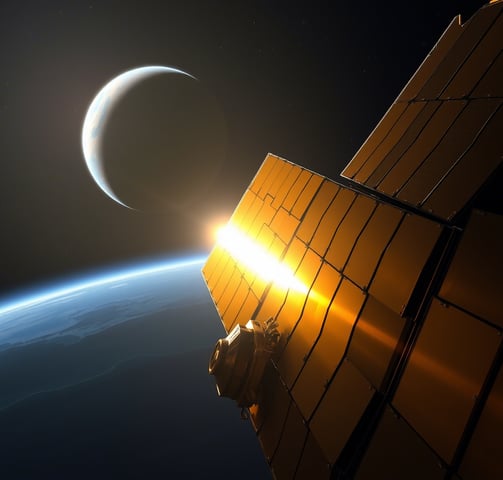

The Kepler Mission and the Exoplanet Hunt
The discovery of K2-18b was not an isolated event, but rather the result of decades of research and the launch of space missions dedicated to exoplanet hunting. The Kepler Space Telescope, launched by NASA in 2009, was a true game-changer in this field. Its primary mission was to observe a small, but dense, region of the Milky Way, monitoring the brightness of over 150,000 stars simultaneously. The method used was the transit method: when a planet passes in front of its star from the telescope's perspective, it causes a small, temporary dip in the star's brightness. By detecting these regular "dips" in starlight, scientists can infer the presence of a planet, its size, and even its orbital period.
The original Kepler mission was a resounding success, revealing thousands of exoplanets and demonstrating that planets are, in fact, common in our galaxy. However, in 2013, the mission faced a serious technical problem: two of the telescope's four reaction wheels, essential for its precise orientation, failed. This could have meant the end of the exoplanet hunt. But, as science often shows us, adversity can lead to innovation. NASA engineers developed an ingenious solution, using the pressure of sunlight to stabilize the spacecraft, giving rise to the "K2" mission. It was during this extended phase of the mission that K2-18b was discovered, a testament to human resilience and creativity in space exploration.
Super-Earths and Mini-Neptunes: A New Planetary Paradigm
K2-18b fits into a category of planets that does not exist in our solar system: "Super-Earths" or "Mini-Neptunes." These worlds are larger than Earth but smaller than gas giants like Neptune and Uranus. For a long time, scientists debated the internal composition of these planets. Were they rocky like Earth, but just larger? Or were they more like mini-gas giants, with a rocky core enveloped by a thick layer of gases? K2-18b, with its mass of 8.6 Earths and radius of 2.6 Earths, is a classic example of this category.
The discovery of water vapor in its atmosphere in 2019, and later, methane and carbon dioxide by the JWST, began to paint a clearer picture. The absence of ammonia, a gas that would be abundant in the atmospheres of planets with large hydrogen envelopes and no deep oceans, suggested that K2-18b could be a "Hycean World". The term "Hycean" is a portmanteau of "hydrogen" and "ocean," describing a planet with a hydrogen-rich atmosphere and a vast liquid water ocean. This is a relatively new idea in astrobiology, and K2-18b has become the prime candidate for studying this type of world. Imagine a planet where the surface is a global ocean, perhaps with some rocky islands emerging, all under a dense, hydrogen-rich atmosphere. It's a very different scenario from Earth, but one that, theoretically, could sustain life. Life, in this case, would likely be aquatic, adapted to high-pressure, low-light conditions, perhaps similar to some forms of life found in Earth's deep oceans or in extreme environments. This is the beauty of astrobiology: it forces us to expand our definition of "life" and "habitability" beyond what we know on our own planet. And K2-18b is an invitation to that expansion of horizons.
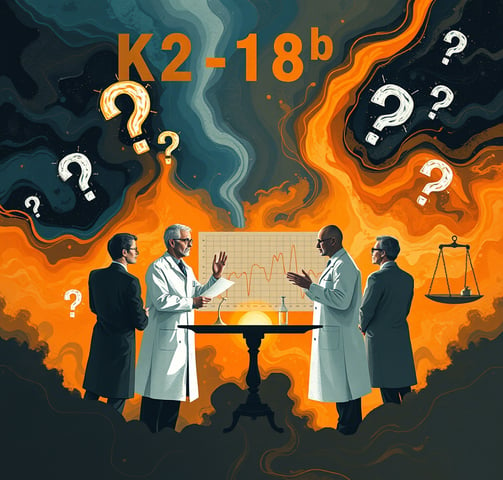

The story of K2-18b, with its discoveries and controversies, is a perfect example of how science advances. It is not a linear path of certainties, but rather an iterative process of hypotheses, observations, analyses, debates, and refinement. And, in this process, controversy is not a sign of weakness, but rather of vitality and scientific rigor.
The fact that K2-18b has generated so much debate about the detection of DMS is, in itself, an advancement. It forces scientists to refine their observation techniques, develop more sophisticated models, and seek new ways to distinguish between biological and non-biological signals. Astrobiology, the field that studies the origin, evolution, distribution, and future of life in the universe, is being driven by these discussions. K2-18b has become a natural laboratory for testing new ideas and technologies in the search for life beyond Earth.
Furthermore, the media and public attention to K2-18b is extremely valuable. It generates interest in science, attracts new talent to the field of astrobiology, and, crucially, can lead to an increase in funding for space research. The search for extraterrestrial life is one of humanity's most ambitious undertakings, and it requires significant resources. The enthusiasm generated by K2-18b, even if sometimes exaggerated, serves as a catalyst for progress.
If, one day, life is indeed confirmed on K2-18b or any other exoplanet, the implications would be profound. It would change our understanding of life's place in the cosmos, suggesting that life may be a common phenomenon, not an anomaly restricted to Earth. It would force us to re-evaluate our own existence and our relationship with the universe. It would be a transformative moment for humanity, with repercussions that would go far beyond science, impacting philosophy, religion, and culture. But, for now, the journey continues, and K2-18b is a beacon of hope and mystery in this relentless search.
Testimonials and Opinions: Scientists, Experts, and Ufologists
To get a complete view on K2-18b and the search for life, it is important to hear different perspectives. Let's see what some scientists, experts, and even ufologists have to say about this discovery that so intrigues us.
The Scientists' View
The scientists directly involved in the research on K2-18b are, for the most part, cautious but optimistic. Professor Nikku Madhusudhan, from the University of Cambridge, leader of the team that detected DMS, is an example. He stated to the BBC:
"Our discovery is a significant step in the search for life beyond Earth. While we cannot claim to have found life, the presence of DMS is a strong indication that requires further investigation. We are incredibly excited about the potential that K2-18b represents for astrobiology."
This statement reflects the balance between the excitement of discovery and the necessary scientific rigor. Dr. Sara Seager, from MIT, reinforces the need for caution, but also the importance of research:
"With thousands of exoplanets in sight, the temptation to overinterpret is strong – and understandable. But we need more data, more observations. K2-18b is a fascinating target, and each new observation brings us closer to understanding whether it is truly habitable or inhabited." [16]
Other scientists, such as Dr. Jake Taylor, from the University of Oxford, represent the voice of constructive skepticism, which is vital for the advancement of science. He and his team are working to offer alternative explanations for the observed signals, ensuring that all possibilities are explored before reaching a definitive conclusion. This is the beauty of the scientific method: debate and challenge are welcome and necessary.
The Ufologists' Perspective
While scientists work with data and models, the ufological community often interprets these discoveries from a different perspective. For many ufologists, the detection of molecules like DMS on K2-18b is seen as a confirmation, or at least a strong reinforcement, of the existence of extraterrestrial life, and in some cases, even advanced civilizations. They tend to connect these discoveries with UFO sightings, conspiracy theories, and the idea that Earth has already been visited by beings from other planets.
A prominent ufologist, who prefers not to be named, commented on an online forum:
"It's obvious they are hiding the truth! K2-18b is just the tip of the iceberg. If James Webb has already found DMS, imagine what else they know and don't tell us. Life is out there, and they are trying to prepare us for the big revelation."
This view, although lacking rigorous scientific evidence, reflects the human yearning for answers and the belief that there is more to the universe than we can see. It is important to note that ufology and astrobiology are distinct fields. Astrobiology is a science that seeks to understand the origin, evolution, distribution, and future of life in the universe, based on observational data and scientific theories. Ufology, on the other hand, investigates unidentified aerial phenomena and reports of extraterrestrial contact, often without the same methodological rigor.
However, the existence of a dialogue, even if indirect, between these communities is inevitable. Astrobiological discoveries, such as those of K2-18b, provide fertile ground for imagination and speculation, and it is natural for different groups to interpret this information according to their own belief systems. The challenge for science is to communicate its discoveries clearly and accurately, without fueling false hopes or misinformation, but also without stifling the curiosity and fascination that drive the search for answers to the great cosmic questions.
Curious and Controversial Facts
* The Subsurface Ocean: One of the most fascinating theories about K2-18b is that it may have a liquid water ocean beneath its hydrogen-rich atmosphere. This would make it an "ocean world" with the potential to harbor aquatic life. Imagine a global, dark, deep ocean, with creatures adapted to a high-pressure environment without direct sunlight. It is a scenario that inspires both science fiction and real research.
* The "Super-Earth" and Habitability: Although K2-18b is in the habitable zone, its mass and atmospheric composition make it very different from Earth. Gravity would be much higher, and atmospheric pressure, overwhelming. This raises the question: could life as we know it survive there? Or would life on K2-18b, if it exists, be in a completely different form, adapted to these extreme conditions? This is one of the big questions scientists are trying to answer.
* The "Fermi Paradox" and K2-18b: The Fermi Paradox questions why, if the universe is so vast and full of stars and planets, we have not yet found evidence of intelligent life. K2-18b, with its promise of biosignatures, rekindles this debate. If life is common, why haven't we detected it on a large scale? Perhaps we are only just beginning to have the right tools to look for it, or perhaps intelligent life is rare, or perhaps, as some ufologists suggest, it is here, but we do not recognize it, or it is hidden from us.
So, what do you think? With each new discovery, the line between science fiction and reality becomes thinner. K2-18b is a reminder that the universe is vast, mysterious, and full of possibilities. And the search for answers continues, driven by human curiosity and the tireless dedication of scientists worldwide.
The Future of the Search: What to Expect?
The case of K2-18b is a vivid reminder that the search for extraterrestrial life is a marathon, not a sprint. There will not be a single "Eureka!" moment that will resolve the question once and for all. Instead, it will be a gradual accumulation of evidence, of clues fitting together, of independent confirmations. And, even when life is finally detected, it is likely to be microbial life, not the advanced civilizations that populate our imagination.
The coming years will be crucial. With the JWST operating at full capacity and future missions being planned, we will have access to even more detailed data from exoplanets. Scientists will continue to refine their analysis techniques, develop new models, and search for a wider range of biosignatures. The detection of multiple biosignatures on a single planet, or the detection of a biosignature in very high concentrations and without plausible abiotic explanations, would be the next major milestones.
In addition to transmission spectroscopy, other techniques are being developed. Next-generation telescopes, both terrestrial and space-based, will have the ability to directly image exoplanets, allowing for the analysis of their atmospheres without the need for a transit. This will open up a universe of possibilities, allowing the study of planets that do not perfectly align with their host stars.
And, of course, the search for life is not limited to exoplanets. The exploration of moons in our own solar system, such as Europa (Jupiter's moon) and Enceladus (Saturn's moon), which harbor subsurface oceans of liquid water, continues to be a priority. These moons may offer more accessible environments for the detection of life, and future missions, such as NASA's Europa Clipper, promise to give us a glimpse into these ocean worlds.
Ultimately, the search for extraterrestrial life is a search for ourselves. It forces us to question our uniqueness, to re-evaluate our place in the cosmos, and to expand our understanding of what is possible. K2-18b, with all its complexity and controversy, is a symbol of this search. It reminds us that the universe is vast and mysterious, and that the greatest discoveries are yet to come. And you, the reader, are part of this journey, accompanying, questioning, and marveling at the secrets the cosmos still holds.
A Continuous Journey
The story of K2-18b is a testament to tireless human curiosity and the power of science. We started with the detection of a distant point of light, moved through the discovery of water and gases in its atmosphere, and arrived at the exciting, yet controversial, possibility of biosignatures. With each step, science brings us closer to answering the fundamental question: Are we alone?
Although the confirmation of life on K2-18b has not yet arrived, the debate and research surrounding it are already pushing astrobiology to new frontiers. It reminds us that science is a dynamic process, where skepticism and validation are as important as the initial discovery. And, above all, K2-18b invites us to dream, to imagine the worlds that exist beyond our own, and to continue the search for the universe's secrets. The journey is just beginning.
What to Expect from the Discovery (and Controversy)
Experiments and the Relentless Search
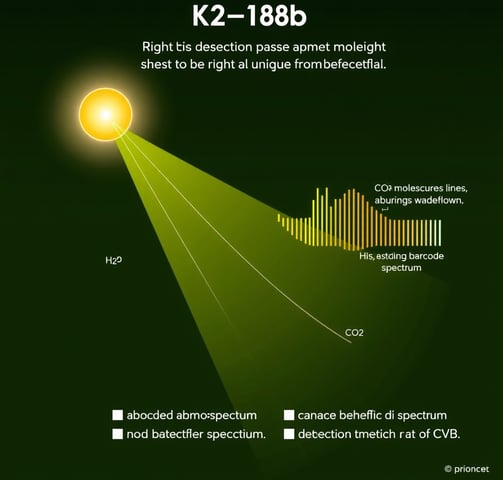

How are scientists trying to unravel these mysteries? The "experiments" to verify life on K2-18b, and on other exoplanets, are not like those we do in a laboratory here on Earth. We cannot send a probe to K2-18b – yet. The distance of 124 light-years makes this unfeasible with current technology. Instead, scientists use extremely sophisticated remote observation techniques.
The main method employed is transmission spectroscopy. It works like this: when an exoplanet passes in front of its star (an event called a transit), a small part of the star's light passes through the planet's atmosphere. The molecules present in that atmosphere absorb specific wavelengths of light, leaving unique "fingerprints" in the light spectrum that reaches us. It's as if each molecule has a luminous signature. By analyzing these signatures with powerful telescopes like the JWST, scientists can identify the gases present in the planet's atmosphere.
In the case of K2-18b, this is how water vapor, methane, carbon dioxide, and possibly DMS were detected. The JWST data is incredibly detailed, but the interpretation of this data is complex. Small variations in the signals can lead to different conclusions, and that's where the scientific debate comes in. Researchers need to be sure that the signal they see is truly from a particular molecule and not from another, or from some kind of interference.
The next steps to confirm these discoveries and advance the search for life on K2-18b include:
* More Observations with the JWST: Madhusudhan's team and other research groups plan to conduct more observations of K2-18b with the JWST. The more data collected, the stronger the signal will be, and the easier it will be to confirm or refute the presence of DMS and other biosignatures.
* Independent Analyses: Other teams of scientists will continue to analyze existing and future data independently. This cross-validation is fundamental to scientific credibility.
*Advanced Atmospheric Modeling: Scientists are developing increasingly sophisticated computational models to simulate the atmospheric conditions of K2-18b and understand how different molecules behave in its environment. This helps interpret observational data and predict what other molecules might be present.
* Search for Other Biosignatures: In addition to DMS, researchers are looking for other molecules that could indicate the presence of life, such as oxygen, ozone, phosphine (which caused controversy on Venus), and others. The detection of multiple biosignatures would be a much stronger indication of life than the detection of just one.
It's a cosmic detective work, where each new observation is a clue, and each analysis is a piece of the puzzle. And patience is an essential virtue in this field.
Our cosmic protagonist, exoplanet K2-18b, is not a recent discovery. It was initially identified in 2015 by NASA's Kepler Space Telescope's K2 mission, an initiative dedicated to hunting for planets outside our solar system. Imagine the excitement of astronomers detecting a new point of light, a subtle shadow passing in front of a distant star, indicating the presence of a previously unknown world!
But what makes K2-18b so special? Well, it orbits a red dwarf star called K2-18, located approximately 124 light-years away from Earth, in the constellation Leo. To put that into perspective, a light-year is the distance light travels in one year, which is an unimaginably vast distance. So, when we talk about 124 light-years, we are looking into the past, to how the planet was 124 years ago!
K2-18b is classified as a "Super-Earth" or "Mini-Neptune." This means it is significantly larger than Earth but smaller than Neptune. To be more precise, it is about 8.6 times more massive and 2.6 times larger than our planet. Think about it: a giant world, with a very different gravity from ours. Could you jump higher there? Probably not, gravity would be much stronger!
The most intriguing thing about K2-18b is that it resides in its star's "habitable zone." What is the habitable zone? It's the region around a star where conditions are ideal for liquid water to exist on a planet's surface. And why is liquid water so important? Because, as far as we know, it is a fundamental ingredient for life as we know it. Without it, life on Earth would not exist. The estimated average temperature on K2-18b ranges between -73°C and 47°C, which, in theory, would allow for the existence of water in a liquid state. It completes an orbit around its star every 33 days, which means a year on K2-18b flies by!
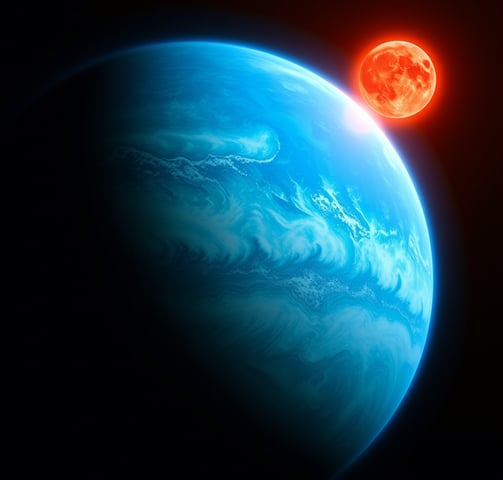

The Impact of the Discovery (and Controversy) on Astrobiology
Even if the confirmation of life on K2-18b is pending, the discussion surrounding it already has a profound impact. The expectation is that this "discovery" – even if not yet fully proven – will further boost astrobiology and the search for life beyond Earth. K2-18b has become a natural laboratory, a priority target for future observations and studies. The attention it has received is already generating more funding and interest in the area, which is great for the advancement of science.
Furthermore, the controversy surrounding DMS highlights the importance of scientific rigor and independent validation in such significant discoveries. It is a reminder that science is not a dogma, but a continuous process of questioning, experimentation, and review. The scientific community's ability to self-correct and openly debate evidence is one of its greatest strengths.
If, in the future, the presence of DMS is confirmed and its biological origin is established, the implications would be monumental. This would change our understanding of life's place in the universe, suggesting that life may be much more common than we imagine, and that it can thrive in environments very different from ours. It would be the first concrete step towards answering the question that has haunted us for millennia: Are we alone? And if we are not, what would this life be like? Would it be microbial, like the algae that produce DMS on Earth, or something more complex? The imagination soars!
Facts and Myths: Separating the Wheat from the Chaff
With so much information and speculation, it’s easy to get lost between what is fact and what is myth. Let’s clarify some points:
* Fact: K2-18b is a real exoplanet, discovered in 2015, orbiting in the habitable zone of its red dwarf star K2-18. It is 124 light-years from Earth [1].
* Fact: Water vapor was detected in its atmosphere in 2019 by the Hubble Space Telescope [4].
* Fact: Methane and carbon dioxide were detected in its atmosphere in 2023 by the James Webb Space Telescope [6].
* Fact: There was a possible detection of Dimethyl Sulfide (DMS) in April 2025, a molecule that on Earth is associated with life. However, this detection is controversial and requires further validation [8, 11].
* Myth: Life on K2-18b has been confirmed. It has not. The detection of DMS is only a possibility and is under intense scientific scrutiny. There is no conclusive proof of life to date.
* Myth: K2-18b is a "second Earth." It is not. K2-18b is a Super-Earth/Mini-Neptune, much larger than Earth (8.6 times more massive and 2.6 times larger) and with a hydrogen-rich atmosphere, which makes it fundamentally different from our planet. Conditions on the surface, if any, would be very distinct.
* Myth: Experiments to verify existing life have already been done and confirmed life. No. The "experiments" are spectroscopic observations of the atmosphere, which search for "biosignatures" – molecules that could indicate the presence of life. They are not direct tests for life, and the interpretation of these signals is complex and subject to debate.
* Myth: NASA has confirmed extraterrestrial life. No. NASA and other space agencies are very cautious in their statements. They speak of "possible biosignatures" or "indications," but never of confirmation, unless the evidence is irrefutable, which is not yet the case for K2-18b.
It is crucial to understand this distinction. Science advances based on evidence and validation, not speculation. And the search for extraterrestrial life is one of the greatest scientific challenges, requiring patience and rigor.
Detailing the Facts and Debunking the Myths
Let's delve a little deeper into the facts and myths surrounding K2-18b, as it is essential that you, the reader, can discern accurate information from speculation.
* Fact: K2-18b is a real exoplanet, discovered in 2015, orbiting in the habitable zone of its red dwarf star K2-18. It is 124 light-years from Earth.
* Detail: The initial discovery was made by the Kepler Space Telescope, which revolutionized the search for exoplanets. The transit method, which detects small dips in a star's brightness when a planet passes in front of it, allowed for the identification of K2-18b. The distance of 124 light-years means that the light we see today from K2-18b left there 124 years ago. This gives us a fascinating perspective on time and space, and the inherent difficulty in studying such distant objects.
* Fact: Water vapor was detected in its atmosphere in 2019 by the Hubble Space Telescope.
* Detail: This was one of the first and most significant detections of water on an exoplanet in the habitable zone. The University College London (UCL) team, led by Dr. Angelos Tsiaras, was responsible for this discovery. The presence of water is crucial because, on Earth, liquid water is an essential solvent for the chemical reactions that sustain life. The detection of water vapor does not mean there are liquid oceans on the surface, but it suggests that conditions for the formation of liquid water may exist somewhere on the planet, perhaps beneath the dense atmosphere.
* Fact: Methane and carbon dioxide were detected in its atmosphere in 2023 by the James Webb Space Telescope.
* Detail: The unprecedented infrared capabilities of the JWST allowed for a much more detailed analysis of K2-18b's atmosphere. The detection of methane (CH4) and carbon dioxide (CO2) is important because these gases are common components of planetary atmospheres and can be produced by both biological and geological processes. The absence of ammonia (NH3) in K2-18b's atmosphere, which would be expected on a planet with a large hydrogen envelope and no deep oceans, was one of the factors that led to the hypothesis that K2-18b is a "Hycean World" – a planet with a vast liquid water ocean beneath a hydrogen-rich atmosphere. This is a class of planets that may be much more common in the universe than rocky "Earths," and that significantly expands the possibilities of habitability.
* Fact: There was a possible detection of Dimethyl Sulfide (DMS) in April 2025, a molecule that on Earth is associated with life. However, this detection is controversial and requires further validation.
* Detail: This is the most controversial point and the core of the current discussion. The team of Professor Nikku Madhusudhan, from the University of Cambridge, used JWST data to identify what they believe to be the DMS signal. On Earth, DMS is almost exclusively produced by living organisms, especially marine phytoplankton. This makes it an intriguing "biosignature." However, the scientific community, including researchers like Jake Taylor from the University of Oxford and Sara Seager from MIT, raised serious doubts about the statistical robustness of this detection. They argue that the signal may be too weak to be conclusive, or that there may be other non-biological explanations for the presence of DMS, such as geological or chemical processes that do not involve life. Science requires a very high level of confidence (usually 5 sigma) to consider a discovery confirmed, and the detection of DMS on K2-18b has not yet reached that threshold. It is a reminder that science is a process of self-correction and that caution is fundamental in such impactful discoveries.
* Myth: Life on K2-18b has been confirmed. It has not.
* Debunking: This is the biggest misinformation circulating. No space agency or serious scientific institution has confirmed the existence of life on K2-18b. The detection of DMS is a possibility that is being investigated. It's like finding a footprint in the sand and wondering if it was an animal or the wind that made it. It's a clue, not proof. The media, in its pursuit of sensational headlines, often oversimplifies or distorts scientific discoveries, leading to widespread misunderstandings. It is crucial for the public to understand that "possible indication" is very different from "confirmation."
* Myth: K2-18b is a "second Earth." It is not.
* Debunking: K2-18b is fundamentally different from Earth. It is a Super-Earth/Mini-Neptune, with a significantly larger mass and radius than Earth. Its atmosphere is rich in hydrogen, while ours is rich in nitrogen and oxygen. If there is an ocean, it would be under a dense and pressurized atmosphere. Conditions on the surface, if any, would be inhospitable to terrestrial life. The idea of a "second Earth" evokes images of a blue and green planet, with continents and open oceans, but K2-18b is a much more exotic and mysterious world. The search for "second Earths" continues, but K2-18b represents a different class of potentially habitable worlds.
* Myth: Experiments to verify existing life have already been done and confirmed life. No.
* Debunking: There are no in situ (on-site) experiments on K2-18b. All information is obtained through remote observations, mainly through transmission spectroscopy. There are no probes or rovers exploring its surface. The detection of "biosignatures" is the search for molecules that, on Earth, are produced by life. However, science is still developing the ability to distinguish between biosignatures and "false positives" – molecules that can be produced by non-biological processes. It is a constantly evolving field of research, and caution is the norm. The complexity of interpreting these signals is immense, which is why the scientific community is so rigorous in its analyses.
* Myth: NASA has confirmed extraterrestrial life. No.
* Debunking: NASA and other space agencies are extremely careful with their statements about extraterrestrial life. They follow a strict protocol to avoid the dissemination of inaccurate information. Official statements always emphasize the preliminary nature of discoveries and the need for more data and validation. The confirmation of extraterrestrial life would be a historical event of immense proportions, and it would be announced with the utmost rigor and irrefutable evidence, something that has not yet occurred for K2-18b or any other exoplanet. The excitement is understandable, but scientific accuracy is paramount.
You might also like:
Contact Us


Want to know more? Our "Question and Answer" area is here to answer your questions and start important conversations.
Partners Products
Qualifies for free shipping offer.
Young Scholar Study Bible NKJV (Leather-soft Pink)
U$ 59.99
Amazing Illustrated Bible for Kids
U$ 59.99
Platinum Remnant Study Bible KJV (Genuine Top-grain Leather Gray/White) King James Version
U$ 129.99
Qualifies for free shipping offer.
Qualifies for free shipping offer.
Faith
Exploring the biblical truth and knowledge.
COMMUNITY
+55 95 98117-7630
© 2024 - 2025. All rights reserved.
Hamillton Rice Street 114 - Boa Vista- RR - BR






